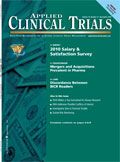Compliance: Suicidality Monitoring
Applied Clinical Trials
eC-SSRS can serve as an effective approach to meeting the pending FDA regulations.
The increased suicidality risk attributed to new drugs is a cause of heightened safety concerns among patients, sponsors, and regulators. Even medicines previously thought to have minimal effects on the central nervous system can pose a potential suicidality risk.

Michael Federico
To address this problem and safeguard health, the FDA issued the draft guidance for prospective suicidality monitoring.
Historically, as new safety requirements have been introduced, the responsibility to produce reliable assessments in clinical trials falls to the investigator sites. It is essential that pharmaceutical companies identify a reproducible suicidality monitoring method to relieve the burden on investigator sites and facilitate compliance.
Using computer-automated interviewing methods to support site efforts is not new. It has actually been in practice for over 35 years, triggered by concerns about the procedural reliability of assessments performed by human raters. Studies demonstrate that patients tend to disclose more suicidal thoughts and behaviors in computer interviews. A new electronic solution will prospectively monitor suicidality in clinical trials in a scientifically-sound, cost-effective, and reliable way. The eC-SSRS is a self-rated version of the Columbia Suicide Severity Rating Scale (C-SSRS), which is the FDA-approved assessment for prospective monitoring of suicidality.
The eC-SSRS is a fully-structured C-SSRS interview comprised of standardized questions, appropriate branching to follow-up questions, and error-handling routines using interactive voice-response (IVR) technology. Like the C-SSRS, it assesses lifetime suicidality during an initial baseline evaluation and then monitors ideations and behaviors at subsequent study visits.
The industry can benefit from using this new approach in a number of ways. First, the C-SSRS algorithm ensures that all questions are asked in a consistent manner, reducing clinical variability. Second, suicidality risks are identified with prompt feedback to study sites for timely follow-up. Third, the investigator site burden is reduced and sponsors can save as much as 45 percent.
The eC-SSRS is designed to meet the objectives of the FDA guidance for prospective suicidality monitoring by providing procedural reliability in content and delivery, scalability for delivery to thousands of patients with accurate recording, and storage and documentation of patient responses.
Kelly Posner, PhD, primary author of the C-SSRS, has stressed the need for improved and more standardized suicidality monitoring. Closely collaborating in the design and implementation of the eC-SSRS, she believes it is a faithful and accurate representation of the "perfect" C-SSRS interview and has been carefully designed to produce consistent outcomes.
Recently, in a survey of more than 250 clinicians and study managers, 99 percent of respondents agreed that the eC-SSRS can serve as an effective approach to meeting the pending FDA regulatory requirements. An impressive 97 percent of respondents stated that using this coordinated self-rated solution versus a clinician-only administered approach could reduce their costs.
The eC-SSRS is a powerful new tool for suicidality monitoring and patient safety. Risk is assessed reliably and reproducibly in line with upcoming regulatory requirements. It is essential that pharmaceutical companies embrace this effective monitoring method to relieve site burden.
Michael Federico Vice President, ePRO Solutions ERT mfederico@ert.com

FDA Fast Tracks Johnson & Johnson’s Nipocalimab for Fetal Neonatal Alloimmune Thrombocytopenia
March 27th 2024Johnson & Johnson is moving forward with a pair of Phase III trials of nipocalimab to reduce the risk of fetal neonatal alloimmune thrombocytopenia in alloimmunized pregnant patients.